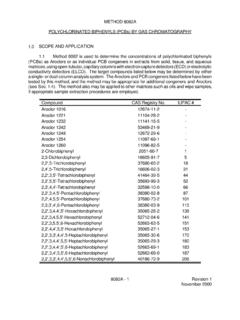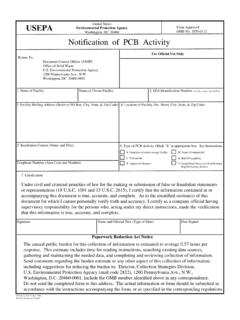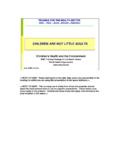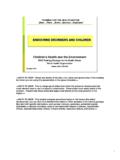Transcription of Chapter 5.10 Polychlorinated biphenyls (PCBs)
1 WHO Regional Office for Europe, Copenhagen, Denmark, 2000 1 Chapter Polychlorinated biphenyls ( pcbs ) General description Physical and chemical properties Polychlorinated biphenyls ( pcbs ) are aromatic, synthetic chemicals which do not occur naturally in the environment. They consist of the biphenyl structure with two linked benzene rings in which some or all of the hydrogen atoms have been substituted by chlorine atoms. The basic molecular structure, including the conventional numbering of the substituent positions, is shown in Fig.
2 1. Fig. 1. Structural formula of pcbs The chemical formula of pcbs is C12H10-nCln, where n ranges from 1 to 10. Theoretically, 209 different congeners are possible, but only about 130 of these have been identified in commercial products. Ballschmiter and Zell (1) proposed a numbering system for the PCB congeners which has been adopted by the International Union of Pure and Applied Chemists (IUPAC) (Table 1). All congeners of pcbs are lipophilic and their lipophilicity increases with increasing degree of chlorination. However, they have very low water solubilities. Congeners with a lower degree of chlorination are more volatile than those with a higher degree.
3 Pure individual PCB congeners are colourless and often crystalline. Commercial PCB mixtures are clear to light yellow oils or resins and they do not crystallize, even at low temperatures. pcbs are practically fire resistant because of their high flash points (170 380 C). They form vapours which are heavier than air, but are not explosive. They have low electrical conductivity, high thermal conductivity and high resistance to thermal degradation. On the basis of these properties they have been used as dielectric isolators in electrical equipment. Like many organochlorine compounds, many of the congeners are highly persistent and accumulate within food chains.
4 Investigations in many parts of the world have revealed widespread distribution of pcbs in the environment. The universal distribution of pcbs throughout the world, suggests that pcbs are transported in air (2). The ability of pcbs to co-distil, volatilize from landfills into the atmosphere (adsorption to aerosols with a particle size of < 20 m), and resist degradation at low incinerating temperatures, makes atmospheric transport the primary mode of global distribution. In a study in the USA, 92% of the pcbs detected were in the vapour phase (2). In a German study, congeners with a low degree of chlorination were dominant in filtered air, whereas those with a high degree dominated in aerosols and rainfall (2).
5 Chapter pcbs Air Quality Guidelines Second Edition WHO Regional Office for Europe, Copenhagen, Denmark, 2000 2 Table 1. IUPAC numbers and chlorine atom positions of all PCB congeners (1) a No. Structure No. Structure No. Structure No. Structure 1 2 3 4 5 2 3 4 2,2' 2,3 56 57 58 59 60 2,3,3',4' 2,3,3',5 2,3,3',5' 2,3,3',6 2,3,4,4' 111 112 113 114** 115 2,3,3',5,5' 2,3,3',5,6 2,3,3',5',6 2,3,4,4',5 2,3,4,4',6 166 167** 168 169* 170** 2,3,4,4',5,6 2,3',4,4',5,5' 2,3',4,4',5',6 3,3',4,4',5,5' 2,2',3,3',4,4',5 6 7 8 9 10 2,3' 2,4 2,4' 2,5 2,6 61 62 63 64 65 2,3,4,5 2,3,4,6 2,3,4',5 2,3,4',6 2,3,5,6 116 117 118** 119 120 2,3,4,5,6 2,3,4',5,6 2,3',4,4',5 2,3',4,4',6 2,3',4,5,5' 171 172 173 174 175 2,2',3,3',4,4',6 2,2',3,3',4,5,5' 2,2',3,3',4,5,6 2,2',3,3',4,5,6' 2,2',3,3',4,5',6 11 12 13 14 15 3,3' 3,4 3,4' 3,5 4,4' 66 67 68 69 70 2,3',4,4' 2,3',4,5 2,3',4.
6 5' 2,3',4,6 2,3',4',5 121 122 123** 124 125 2,3',4,5',6 2',3,3',4,5 2',3,4,4',5 2',3,4,5,5' 2',3,4,5,6' 176 177 178 179 180** 2,2',3,3',4,6,6' 2,2',3,3',4',5,6 2,2',3,3',5,5',6 2,2',3,3',5,6,6' 2,2',3,4,4',5,5' 16 17 18 19 20 2,2',3 2,2',4 2,2',5 2,2',6 2,3,3' 71 72 73 74 75 2,3',4',6 2,3',5,5' 2,3',5',6 2,4,4',5 2,4,4',6 126* 127 128 129 130 3,3',4,4',5 3,3',4,5,5' 2,2',3,3',4,4' 2,2',3,3',4,5 2,2',3,3',4,5' 181 182 183 184 185 2,2',3,4,4',5,6 2,2',3,4,4',5,6' 2,2',3,4,4',5',6 2,2',3,4,4',6,6' 2,2',3,4,5,5',6 21 22 23 24 25 2,3,4 2,3,4' 2,3,5 2,3,6 2,3',4 76 77* 78 79 80 2',3,4,5 3,3',4,4' 3,3',4,5 3,3',4,5' 3,3',5,5' 131 132 133 134 135 2,2',3,3',4,6 2,2',3,3',4,6' 2,2',3,3',5,5' 2,2',3,3',5,6 2,2',3,3',5,6' 186 187 188 189** 190 2,2',3,4,5,6,6' 2,2',3,4',5,5',6 2,2',3,4',5,6,6' 2,3,3',4,4',5,5' 2,3,3',4,4',5,6 26 27 28 29 30 2,3',5 2,3',6 2,4,4' 2,4,5 2,4,6 81 82 83 84 85 3,4,4',5 2,2',3,3',4 2,2',3,3',5 2,2',3,3',6 2,2',3,4,4' 136 137 138 139 140 2,2',3,3',6,6' 2,2',3,4,4',5 2,2',3,4,4',5' 2,2',3,4,4',6 2,2',3,4,4',6' 191 192 193 194 195 2,3,3',4,4',5',6 2,3,3',4,5,5',6 2,3,3',4',5,5',6 2,2',3,3',4,4',5,5' 2,2',3,3',4,4',5,6 31 32 33 34 35 2,4',5 2,4',6 2',3,4 2',3,5 3,3',4 86 87 88 89 90 2,2',3,4,5 2,2',3,4,5' 2,2',3,4,6 2,2',3,4,6' 2,2',3.
7 4',5 141 142 143 144 145 2,2',3,4,5,5' 2,2',3,4,5,6 2,2',3,4,5,6' 2,2',3,4,5',6 2,2',3,4,6,6' 196 197 198 199 200 2,2',3,3',4,4',5,6' 2,2',3,3',4,4',6,6' 2,2',3,3',4,5,5',6 2,2',3,3',4,5,6,6' 2,2',3,3',4,5',6,6' 36 37 38 39 40 3,3',5 3,4,4' 3,4,5 3,4',5 2,2',3,3' 91 92 93 94 95 2,2',3,4',6 2,2',3,5,5' 2,2',3,5,6 2,2',3,5,6' 2,2',3,5',6 146 147 148 149 150 2,2',3,4',5,5' 2,2',3,4',5,6 2,2',3,4',5,6' 2,2',3,4',5',6 2,2',3,4',6,6' 201 202 203 204 205 2,2',3,3',4',5,5',6 2,2',3,3',5,5',6,6' 2,2',3,4,4',5,5',6 2,2',3,4,4',5,6,6' 2,3,3',4,4',5,5',6 41 42 43 44 45 2,2',3,4 2,2',3,4' 2,2',3,5 2,2',3,5' 2,2',3,6 96 97 98 99 100 2,2',3,6,6' 2,2',3',4,5 2,2',3',4,6 2,2',4,4',5 2,2',4,4',6 151 152 153 154 155 2,2',3,5,5',6 2,2',3,5,6,6' 2,2',4,4',5,5' 2,2',4,4',5,6' 2,2',4,4',6,6' 206 207 208 209 2,2',3,3',4,4',5,5',6 2,2',3,3',4,4',5,6,6' 2,2',3,3',4,5,5',6,6' 2,2',3,3',4,4',5,5',6,6' 46 47 48 49 50 2,2',3,6' 2,2',4,4' 2,2',4,5 2,2',4,5' 2,2',4,6 101 102 103 104 105** 2,2',4,5,5' 2,2',4,5,6' 2,2',4,5',6 2,2',4,6,6' 2,3,3',4,4' 156** 157** 158 159 160 2,3,3',4,4',5 2,3,3',4,4',5' 2,3,3',4,4',6 2,3,3',4,5,5' 2,3,3',4,5,6 51 52 53 54 55 2,2',4,6' 2,2',5,5' 2,2',5,6' 2,2',6,6' 2,3,3',4 106 107 108 109 110 2,3,3',4,5 2,3,3',4',5 2,3,3',4,5' 2,3,3',4,6 2,3,3',4'.
8 6 161 162 163 164 165 2,3,3',4,5',6 2,3,3',4',5,5' 2,3,3',4',5,6 2,3,3',4',5',6 2,3,3',5,5',6 a Marked congeners have been assigned "toxic equivalency factors" (TEFs): * non-ortho congener; ** mono-ortho congener; ** di-ortho congener. These congeners are also chlorinated in both para and at least two meta positions. Chapter pcbs Air Quality Guidelines Second Edition WHO Regional Office for Europe, Copenhagen, Denmark, 2000 3 Sources Polychlorinated biphenyls ( pcbs ) have been used commercially since 1929 as dielectric and heat exchange fluids and in a variety of other applications. However, the distribution of pcbs in the environment was not recognized until 1966, when Jensen identified pcbs in human and wildlife samples (3).
9 Many countries and intergovernmental organizations have now banned or severely restricted the production, use, handling, transport and disposal of pcbs . It should also be mentioned that when de novo synthesis of pcbs occurs, in combustion processes, the congener composition is different from that of commercial mixtures. Occurrence in air Few studies have been conducted to measure ambient air levels of pcbs , but concentrations appear to differ markedly between locations. Owing to variations in the analytical procedures used, concentrations measured in independent studies must be evaluated with caution.
10 The lowest levels, from ng/m3, are found in non-industrialized and non-contaminated areas, whereas levels of ng/m3 have been measured in the Ruhr area in Germany (2). Near a waste landfill in Yugoslavia and close to industrial plants in Japan, levels of up to 45 and 650 g/m3, respectively, were found (2). Higher levels are found indoors than outdoors. In the USA indoor levels ranged from 44 to 240 ng/m3, while maximum outdoor levels were 18 ng/m3 (2). The levels of airborne pcbs were two times higher (457 223 ng/m3) in buildings with PCB transformers, than in buildings without them (229 106 ng/m3) (2).















